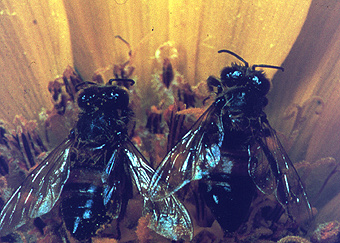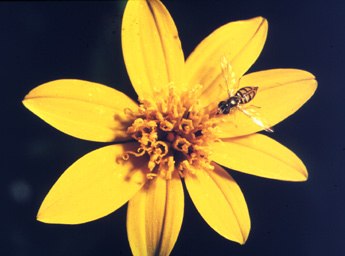
Which is the Africanized Honey Bee?
(Bees were preserved in alcohol)
AHB Note: Africanized honey bees look just like regular European honey bees. The differences cannot be seen just by looking at them.
Grades: 9-12
Essential Skills: Science
Duration: 1 class period
OVERVIEW
Students will examine and dissect a worker honey bee to learn the structures and functions of honey bees.
Teacher Preparation:
Curriculum Support Materials:
1. AHB and EHB in plastic
Other Materials:
1. Prepared slides and mounts of honey bees
2. Posters showing honey bee or insect external structure
3. Brood comb obtained from a beekeeper
Information Sheets:
Activity Sheets:
Lesson Plan
Introduction activity (10 minutes)
Ask the students what Africanized honey bees look like.
AHB Note: Africanized honey bees look just like regular European honey bees. The differences
cannot be seen just by looking at them.

Which is the Africanized Honey Bee?
(Bees were preserved in alcohol)
Explain to the students how scientists tell if a colony of honey bees is Africanized.
Bee scientists at the U.S. Department of Agriculture came up with a method they call the Fast Africanized Bee Identification System or FABIS. Africanized honey bees are just slightly smaller than European honey bees. Scientists obtain a sample of at least 10 bees from a colony and measure the length of the forewing. For this activity we will assume that if the average wing length of 10 bees is less than 3/8inch long then the bees are from an Africanized colony. For the actual test however, the criteria are quite a bit more complicated.
Explain that if the FABIS test is not conclusive for a given colony, then the samples are put through another test called Universal System for Detecting Africanization (USDA-ID). In this test 26 separate measurements are taken from a number of bees and the results are analyzed using a computer.
Activity 1 Bee dissection (45 minutes)
Obtain dead worker bees from a beekeeper (freeze them, and then put them into 70% ethyl alcohol) or already preserved specimens from Carolina Biological Supply. Have the students dissect a bee's mouthparts and stinger. Have them draw the structures they see and then compare them to drawings or electron micrographs from the books listed in the Bibliography.
Distribute Activity Sheets 26, 27 and 31. Have the students examine slides of honey bee mouthparts and legs under the microscope. Also examine the bees in plastic under the micro scope. Discuss the function of structures identified. (Note: Some students may protest the use of real animals for dissections. Computer software is available which will show these structures as well.)
Have the students examine brood comb with immature bees, and investigate the life stages of the honey bee. Does the Africanized honey bee develop at the same rate as the European honey bee (see Activity Sheet 12). Have the students write a report about what happens within a honey bee colony.
Activity 2 Africanized or not (30 minutes)
Make copies of Activity Sheet 11 and distribute them. (Remember that the files you downloaded may not be the original size.) Have groups of students measure the lengths of the forewings as indicated in the example. Have them add the total for 10 wings and then divide by 10 to obtain the average. If the average is larger than .375 inch (3/8-inch) the colony is European in origin.
Honey bee identification may often be difficult because so many insects resemble honey bees. The resemblance is no accident.
Distribute Information Sheet 11 and discuss the different types of mimicry. If a fly species (that has no stinger and does not bite) mimics a honey bee, what type of mimicry is it? If a small solitary bee with a stinger mimics a honey bee, what type of mimicry is it?

Conclusion (10 minutes)
Discuss whether or not mimicry is effective.
Additions
Words with special meanings:
(for understanding only, not to be tested)
Bibliography:
An Introduction to the Study of Insects, by D. J. Borer, D. M. DeLong, and C. A. Triplehorn. Published
by Holt, Rinehart and Winston, NY., 1976.
A Scanning Electron Microscope Atlas of the Honey Bee, by E. H. Erickson, Jr., S.D. Carlson, and
M.B. Garment. Published by Iowa State University Press, Ames, IA.,1986.
The Compound Eye of Insects, by H. A. Horridge. Article in Scientific American, July 1977.
Anatomy and Physiology of the Honeybee, by R. E. Snodgrass. Published by McGraw-Hill Book Co.,
New York,1925.
Anatomy of the Honey Bee, by R. E. Snodgrass. Published by Comstock Publishing Associates, Ithaca,
N.Y., 1956. Available from Wicwas Press, Chesire CT.